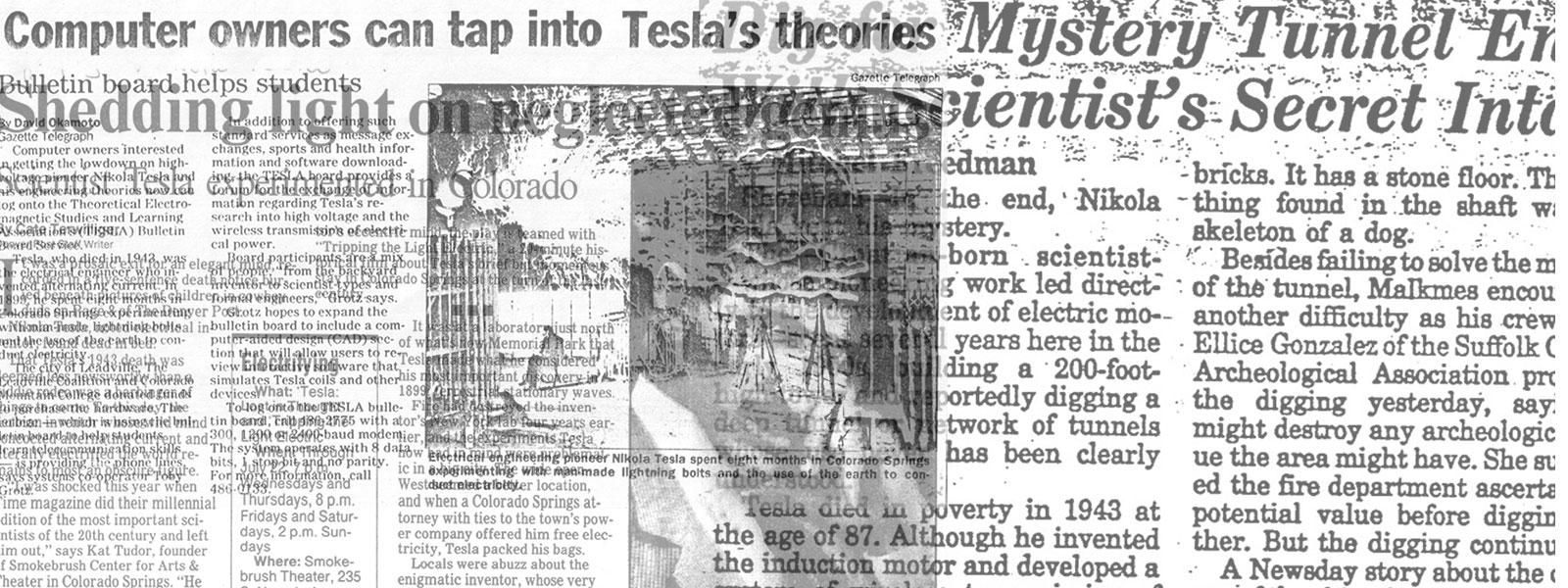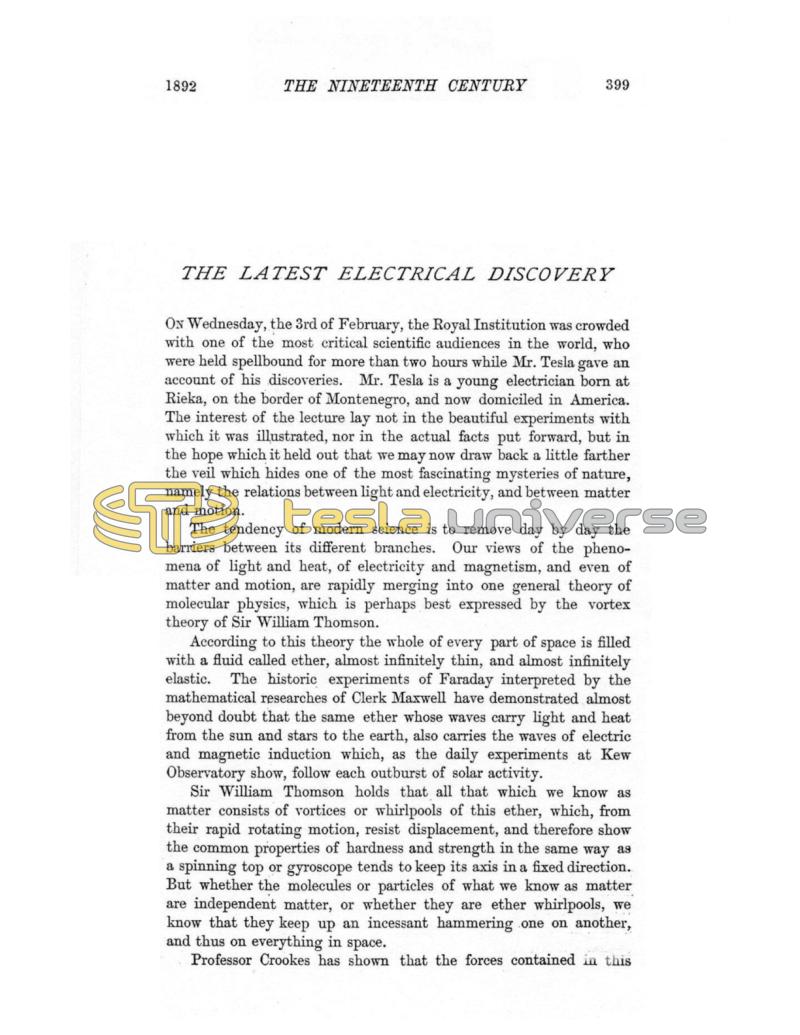
Nikola Tesla Articles
The Latest Electrical Discovery
On Wednesday, the 3rd of February, the Royal Institution was crowded with one of the most critical scientific audiences in the world, who were held spellbound for more than two hours while Mr. Tesla gave an account of his discoveries. Mr. Tesla is a young electrician born at Rieka, on the border of Montenegro, and now domiciled in America. The interest of the lecture lay not in the beautiful experiments with which it was illustrated, nor in the actual facts put forward, but in the hope which it held out that we may now draw back a little farther the veil which hides one of the most fascinating mysteries of nature, namely the relations between light and electricity, and between matter and motion.
The tendency of modern science is to remove day by day the barriers between its different branches. Our views of the phenomena of light and heat, of electricity and magnetism, and even of matter and motion, are rapidly merging into one general theory of molecular physics, which is perhaps best expressed by the vortex theory of Sir William Thomson.
According to this theory the whole of every part of space is filled with a fluid called ether, almost infinitely thin, and almost infinitely elastic. The historic experiments of Faraday interpreted by the mathematical researches of Clerk Maxwell have demonstrated almost beyond doubt that the same ether whose waves carry light and heat from the sun and stars to the earth, also carries the waves of electric and magnetic induction which, as the daily experiments at Kew Observatory show, follow each outburst of solar activity.
Sir William Thomson holds that all that which we know as matter consists of vortices or whirlpools of this ether, which, from their rapid rotating motion, resist displacement, and therefore show the common properties of hardness and strength in the same way as a spinning top or gyroscope tends to keep its axis in a fixed direction. But whether the molecules or particles of what we know as matter are independent matter, or whether they are ether whirlpools, we know that they keep up an incessant hammering one on another, and thus on everything in space.
Professor Crookes has shown that the forces contained in this bombardment are immensely greater than any forces we have yet handled, many millions of horse power being contained in an ordinary room. Owing, however, to the forces being in every possible direction they neutralise each other, and no result of them is perceivable to our senses; but if ever we discover how to so direct their courses as to send the majority of them in the same direction, we shall have at our disposal forces as much exceeding any we are now acquainted with as the blow struck by a bullet exceeds the force required to pull the trigger of a gun. In fact, as Mr. Tesla put it in his lecture, ‘We shall then hook our machinery on to the machinery of Nature.’ It is because they hold out to us a hope, however distant, of some day so guiding the ether storm, that the experiments of Nikola Tesla are of such transcendent interest and importance.
Professor Crookes, in his experiments on ‘radiant matter,’ has given us the first hint of a method of directing what, for want of more exact knowledge, we will call the molecules of matter. With the appliances at his command, however, he was unable to impart any great change of direction, but he succeeded in making that change manifest by reducing the disturbing forces acting against his directing force. In other words, he pumped out from glass bulbs and tubes nearly all the air or other gas that they contained, and the comparatively few particles left were then free to travel in any course imparted to them without much change caused by collision with others. This special direction was imparted by means of electricity, and gave us the beautiful phenomena of phosphorescence and radiant matter which are now so well known in these experiments.
By means of suitably shaped terminals a stream of molecules is focused on a given point. If a piece of carbon or platinum is placed at that point it becomes white hot under the bombardment, from identically the same cause which causes a sheet of flame to appear when a cannon shot strikes an iron target. If a ruby or other phosphorescent material is placed there it glows with its characteristic colour, and if a little delicately balanced vane or windmill is placed so that the stream is directed on one side of its fans it rapidly revolves. The forces available in these experiments were, however, almost indefinitely small, being as it were merely flying spray from the great torrent into which we have not yet been able to penetrate.
We now come to the advances made by Mr. Tesla.
In all the above experiments the electricity by which the directing force was imparted to the molecules was electricity of a comparatively slow alternation period, namely, electric currents oscillating about 80 to 100 times per second. It was as if we had tried to ventilate a room by causing a man to walk slowly through it with an umbrella. He would undoubtedly move the air, but would move it so slowly that ordinary methods would be insufficient to enable us to perceive its motion. In order to cause a rush of air we must put up a rapidly moving fan or other suitable machinery. Mr. Tesla, seeing this, abandoned the ordinary dynamo, which, as we have already noted, gives about 80 alternations per second, and the ordinary induction coil, which gives about the same number, and boldly constructed a dynamo which gives 20,000 alternations per second, and by connecting this to suitable condensers he multiplied its alternations until they reached 1,000,000 or 1,500,000 per second.
Then at once an entire set of new phenomena appeared, and the experimenter entered a region of mystery and hope. One of the first things noticed was, that either because these vibrations are too rapid to excite corresponding vibrations in the nerves of the body, or from some other cause, no shock is felt from the current; and that though an ordinary current at 2,000 volts will kill, yet this current at 50,000 volts cannot be felt at all.
It was also found that the vibrations keep time in some unknown way with the vibrations of solid matter. Vulcanite is one of the best insulators known, and will entirely stop any ordinary current or discharge, but the stream of sparks between two poles with this current pours through a thick sheet of vulcanite as easily or even with greater ease than through air. It does not perforate it in any way, but passes through it as light passes through glass.
All the ‘Crookes’ phenomena of radiant matter are almost indefinitely increased; it is the blow of mitrailleuse bullets compared to the blow of an air-ball thrown against the wind. The forces can be directed for a considerable distance through space without the aid of wires. Electric lamps light easily when attached to one single wire, and require no return conductor; and, more wonderful still, if metal plates are fixed on the roof and walls of a room and connected to the terminals, the whole atmosphere of that room, whether it be ether or whether it be particles of common matter, is thrown into a state of storm and agitation which can be at once made perceptible by bringing into the space tubes or globes from which the air has been partially exhausted. Such tubes though without any metallic connections yet glow and throb as if powerful currents of electricity were being sent through them from an ordinary induction coil.
A ‘Crookes’ radiometer placed near a metal conductor from which neither spark nor glow is perceptible yet rotates as if it were placed near a lamp or heated body, but rotates in the wrong direction, and, last of all, a true flame burns in which nothing is consumed.
When the discharge issues from a suitable terminal it has the appearance and roaring sound of a gas flame burning under too high a pressure, and gives off a considerable heat; to use Mr. Tesla’s words again: This is not unexpected, as all the force and heat in the universe is due to the falling together of lifted weights, and the same result is produced whether these weights have been lifted apart by chemical energy, and rest in the form of oxygen and hydrogen ready to combine chemically, or in the form of mechanical energy of moving molecules directed by the electric current.’
On the same table, on which Mr. Tesla’s experiments were shown a few days ago, there swung, in the year 1834, a delicately balanced galvanometer needle, under the influence of the first induction current, produced by the genius of Faraday. The force available to move it was very small, probably not greater than the forces lighting Mr. Tesla’s tubes, yet that force has now developed one of the greatest industries of the world. It lights millions of lamps in London and elsewhere, in America it drives cars on thousands of miles of railways, and will soon distribute the power of Niagara Falls to the inhabitants of the neighbouring States. May we not hope for some such development of the new discovery, and that we shall some day harness to our machinery the natural forces, which from the beginning of time have literally been slipping through our fingers?
Should the application of Mr. Tesla’s results ever fulfil the bold dreams of scientific imagination, we shall see a social and political change at least as important as that caused by the railway system or the electric telegraph.
Most manual labour will become unnecessary, as unlimited power will be available at every man’s hand. Engineering works will be able to be carried out on a far greater scale than has yet been even contemplated, and doubtless a corresponding era of material prosperity will set in; but, whether these dreams are ever fulfilled or not, few who attended Mr. Tesla’s lecture will forget the possibilities which seemed to open to their minds when they saw a living man standing in the midst of the electric storm, receiving unharmed in his hands flashes of veritable lightning, and waving above his head a tube, through which the very life blood of creation pulsed, in waves of purple fire.
